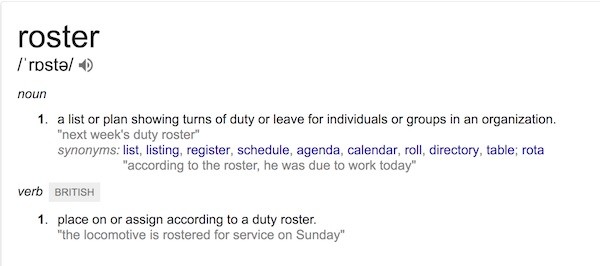When it comes to agency rosters, it is easy to fall into the trap of thinking there are two options: a consolidated model with all of your agency needs within a network agency or holding company solution, or a village model where you have a selection of different marketing agencies and suppliers working together to deliver your marketing requirements. This is what we mean when we are talking about agency rosters. Agency rosters mean all of the various agencies, marketing suppliers and vendors required to deliver the range of services to fulfil your marketing plan.
With the increasing rise of in-house and hybrid agency models, the marketing agency roster can also be in-house, outsourced, or both. In some cases, in-house agency services are actually outsourced to a third-party agency or supplier. These trends and variations mean that marketing roster models are no longer simply consolidated or diversified but an increasingly infinite number of hybrid variations custom-designed to suit the organisation’s marketing needs.
However, many advertisers have yet to significantly review their roster of agencies and marketing suppliers, even though their marketing strategy and plans and, therefore, requirements have significantly changed in the past five to ten years.
What I am talking about here is not an agency review or a pitch to replace an underperforming agency but a total review of the roster to determine the ideal structure, composition, and size. In our experience, this process will deliver a significant increase in agency productivity, reduced costs, and marketing performance for most advertisers.
1. Defining your agency roster
The first challenge often encountered is the limited way many marketers define their roster. Many will have a working roster consisting of perhaps up to half a dozen agencies that are top of mind either due to the high volume of work (and therefore spending) or the visibility of the agency work (usually the creative work). But in fact, this completely ignores what often amounts to a long but important tail within the roster, one that hides significant inefficiencies and poor governance.
Within this group are often the market research companies, numerous design studios and production facilities, along with various shopper marketing, promotions, loyalty agencies, print companies, content creators, and public relations firms. While spending with each of these companies will often be relatively small, collectively, it will amount to a significant proportion of the marketing budget.
Today, an increasing number of technology companies, software developers, and platform suppliers are also being paid from the marketing budget.
Our approach to defining the true agency roster and ensuring nothing is overlooked is to analyse the spending information for all marketing cost codes and to classify the spending using our knowledge of the industry supplier base. Depending on the rigour of the spend management, we capture all of the marketing-related spend, segment the various suppliers, and categorise them by their core capabilities. This process also highlights marketing spend that is not roster-related and allows this to be reviewed.
It has been interesting to see the incredulous response from marketing teams, especially in organisations with decentralised marketing functions, when we present the results. In one case, the team believed the roster was less than twenty agencies and suppliers when, in actual fact, the spend analysis identified more than 400 companies receiving payments from the marketing budget ranging from tens to hundreds of thousands of dollars.
In another case, the process identified significant legacy payments to several agencies and suppliers that had been overlooked and not previously reconciled against the marketing budget. Plus, in companies where the application of the cost codes lacked true diligence, we found significant spends in the hundreds of thousands of dollars that had been allocated to marketing but was not a marketing budget item. Subsequently, we have found that it is not uncommon and is often hidden from the budget owner.
Once the roster is defined by the spend data, we can start the process of reviewing the total spend, identifying opportunities to eliminate duplication and inefficiencies, and optimising the roster to the strategic needs.
2. Reviewing investment levels
It is interesting how often relatively small spending amounts are overlooked in the budget, especially as collectively, these spending amounts accumulate to a significant component of the marketing budget. It is often confusing for people that this fragmented spending is actually incredibly inefficient. So, while marketers may think they are getting a low price, the hidden costs of managing and maintaining this bloated roster of agencies eliminate those cost efficiencies.
A procurement approach would be to eliminate the fragmented spending by deleting all small-spend suppliers from the roster. The problem with this is that many of these small-spend suppliers are such because they provide emerging capabilities and have been added to the roster to test and possibly increase the spending with these suppliers depending on the results.
Another procurement approach would be to create buckets of capabilities and have the existing suppliers and possibly other competitive suppliers tender to be either appointed preferred suppliers or added to a panel.
Our recommendation is that before either of these approaches is taken, there should be first an analysis of each category to determine the addressable and non-addressable spend in that category or supplier spend and second a calculation of the size of the duplication and the cost efficiency to be delivered depending on the size of the reduction. The larger the reduction, the greater the efficiency increase, depending on the category of capabilities and the addressable spend.
3. Detailing capability requirements
Before you start pruning or hacking at the roster it is important to have a clear view of what you are trying to achieve. Defining a successful roster is ensuring that you have all of the capabilities you need in the smallest number of agencies and suppliers possible.
To do this, you need to review the marketing strategy and plan. This is why a total roster review is ideal immediately after any major change in the marketing strategy.
This is the first part of our Strategic Supplier Alignment process, where we undertake one-on-one interviews with key marketing stakeholders to determine their strategic requirements now and for the foreseeable future. We then discuss which agencies and suppliers are currently providing those capabilities and how well they deliver.
Once we have mapped the current state, we meet with the agencies and suppliers identified as core capability providers to explore what other capabilities they may bring to the roster that the marketers may be unaware of.
This is a delicate and important process as often agencies may overstate their capabilities or purport expertise that they would actually need to outsource. Therefore we carefully explore and use out industry knowledge and expertise to map a realistic view of the roster capabilities.
4. Designing a roster model
Roster design depends on the breadth of services required and the number of agencies and suppliers across the roster. Previously, we provided a comprehensive review of the major agency roster models. But this is now more than six years old, and in that time, the model variants have become more numerous due to the increasing complexity of the marketing plan.
Nevertheless, the models detailed in the review are still excellent starting points for developing the ideal roster model for your needs. But the fact is that there is no longer one model that suits all marketers and their strategic needs. Therefore, it is a matter of reviewing the capabilities required, spending and strategic priorities, and the agency mix and then applying this to each of the models to find the best fit.
Even then it is likely that the model will not fit perfectly as there are no longer any best practice roster models and most will still require customisation to suit the nuances of the specific requirements of the marketing plan. Often this model design finessing occurs during the next step, which is populating the selected model with agencies.
5. Appointing agencies into roles
This process needs careful consideration. There are a number of ways of approaching it, but we recommend using a strategically and financially tiered approach. This means you identify the most important and valuable capabilities and populate these first, then continue through the process down the tiers. To visualise this, we developed the City Model, with the brand or business as the CBD and then the inner suburbs and so on.
As you populate the various positions and capabilities into the model, it will become clear if there are any gaps that need to be filled. But where possible, you should look for solutions to fill these gaps within the existing roster rather than going to market, which is disruptive and time-consuming.
The other consideration in allocating positions in the roster model is the capabilities that need to work together and collaborate directly to deliver the desired outcomes and performance.
A little like a coach placing their players on the field to make a team, you need to consider their strengths and capabilities and how they work together. Increasingly, data and market research, data, and media need to be considered of higher strategic importance than some of the more traditional priorities, such as creative and media.
6. Allocating scopes of work
Once the roster has been populated with the agencies you require to deliver the capabilities, it is a matter of allocating the scope of work for each agency. Scope of work is one of the most effective ways of defining the roles and responsibilities of each agency. The reason it is so effective is the connection between the scope of an agency’s work and the resource required and, more importantly, the fee to be paid to the agency.
The scope of work for each agency must be as detailed and specific as possible. This will ensure the agencies understand their role and responsibilities within the roster. The scope of work needs to be specific enough that the agency can carefully plan the resources it requires and understand the level of remuneration it will receive to deliver the required outcomes.
One of the key reasons we have noted for roster failure after a restructuring process is that this step is either overlooked or the scope of work is so broad or vague that agencies immediately start trying to expand their remit and undermine each other’s scope of work. This leads to conflict and duplication, undermining all of the benefits of the roster review process.
Delivering roster value and performance
Executed correctly and completely, this process delivers significant improvement in roster value with either reduced cost or increased outputs and productivity. You achieve this not by simply reducing agency costs, which is ultimately counterproductive. You will achieve it by creating economies of scale across the roster and eliminating waste, duplication, and misalignment.
In the past ten years, we have undertaken this process for advertisers across a wide range of categories, including automotive, financial services, telecommunications, construction, higher education, and more. We have also reviewed rosters across multiple markets, including regional and global.
In almost every case, even after years of cost reductions, we have typically delivered productivity increases and savings that we reinvested into the marketing plan, leading to increased performance from the entire roster.
You can read more here about how TrinityP3’s Agency RosterAlignment service helps you untangle your supplier roster, understand its strengths and weaknesses, and develop an optimal structure to improve your performance.





